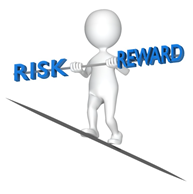Managing Risk for Effective Portfolio Management

One of the basic premises of investing is that investors attempt to maximize the returns from their investments. In doing so, it is assumed that investors are risk averse, that is, given a choice between two assets of equal rate of return, an investor will select the asset with the lower level of risk. Although this relationship does not imply that all investors are risk averse, it does mean that there is a positive relationship between expected return and expected risk. So how do we define risk?
The total risk of return on a security can be broken into two parts, specific risk and market risk.
Total Risk = Specific Risk + Market Risk
Specific risk is that portion of total risk that is specific to an individual security. It is the risk that is associated with factors such as bad management decisions, pending lawsuits, shifts in consumer taste, etc. – risks that are specific in nature. Fortunately, specific risk is also considered as diversifiable risk, meaning that this portion of total risk can be reduced through diversification and allocation. Most investors intuitively realize the benefits of diversification. Much like the adage ‘don’t put all your eggs in one basket,’ investors can stabilize returns by diversifying their investment holdings by asset type (cash, bonds, stock, etc.), by industry sector (consumer discretionary, energy, financials, tech, etc.), by company size (large, medium and small capitalization), and by mutual fund and exchange traded fund objective.
Investors must pay close attention to the asset allocation and the diversification of their portfolios since poorly diversified portfolios increase the specific risk of the portfolio, potentially leading to excessive losses. Unfortunately, this happened to many investors in the late 1990’s. As the euphoria of investor’s expectations pushed the stock market to higher highs, with technology stocks leading the way, many portfolios became over concentrated. Regardless of valuation, investors were chasing the next Microsoft.
Unfortunately, many investors failed to notice the concentrated specific risk that was accumulating due to the excess investing in technology. Not only were stocks becoming excessive in relation to other portfolio assets (funds, cash, bonds), but also the technology sector was becoming dominant in stock industry diversification. And then the bubble burst. The market spiraled down as investor’s portfolios, with excessive specific risk, lost paper profits and more. History repeated itself in 2007, but this time the stock market was lead dramatically lower by financial stocks.
For some, these gut wrenching experiences have pushed the prospects of early retirement to the wayside. For others, they may never return to investing in the stock market. Lesson to learn: avoid the pitfalls of poor asset allocation/diversification – and above all, invest based on your personal risk/return profile. Concentrated portfolios carry unnecessary risk.
Market risk is that portion of total risk that is caused by factors that simultaneously affect the prices of all marketable securities. Market risk is the risk of the security that is associated with factors such as changes in the economy, politics, world events, etc. – risks that are market-wide in nature. Masrket risk is non-diversifiable, and that is why most stocks have a tendency to move together. It is also why investors are exposed to market uncertainties despite how many stocks they own.
Market risk is also referred to as beta, and measures the relationship between market movements and the effect those fluctuations have on the prices of individual securities. For instance, a security with a beta of 1.0 is considered perfectly correlated to the market – if the market goes up or down by ten percent, so too should the individual security. Likewise, if the security has a beta measure of 1.20, the security should be twenty percent more volatile than the market; if the beta of the security is .80 percent, then the security should be twenty percent less volatile than the market universe.
Overall portfolio beta is a useful predictor of the future volatility of your portfolio. For example, a portfolio that has a portfolio beta of 0.93 suggests 7% less volatility than the market portfolio. A portfolio beta of this sort might indicate the investor has conservative objectives. If the beta measurement becomes excessive, consider replacing existing securities with lower beta securities, or add new investments with lower betas. On the contrary, if your portfolio beta is less than 1.0, and you can tolerate more market risk, consider replacing existing securities with higher beta securities, or add new investments with higher betas.
Investment Account Manager is a Windows desk-top based software tool (since 1985) that provides investors with the tools needed to build portfolios commensurate with their risk tolerance, a vital portfolio management task for reaching long-term goals.
A free 60 day demo version (no credit card required) is available on our website: Investment Account Manager